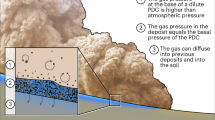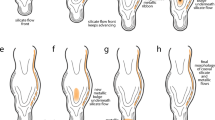Abstract
Walker1 has reported observations made on the volcano Etna of the thickness of solid lava flows and the inclination of the slopes on which they lie. He also made estimates of the viscosity of the lava flowing down the slopes of Etna in May 1966, by measuring the thickness and velocity of flow of the lava and the angle of inclination of the slope. The formulae used to determine the viscosity are those for a Newtonian fluid exhibiting laminar flow. Walker sought a relation between the viscosity of fluid lava, the thickness of solid lava and the inclination of the slopes on which the solid lava lies. It seems, however, that such a relation is unlikely because a lava flow having the properties of a Newtonian fluid would continue to flow until no lava at all remained on the sloping surface. Hot lava is observed to flow and cold lava is found to rest on sloping surfaces, however, so we may surmise that flowing lava is not Newtonian in its behaviour, at least as it approaches a fully solid state. Walker's valuable observations enable these questions to be investigated. If the thickness of solid lava flows were determined by the viscosity of the lava when liquid, if this had the properties of a Newtonian fluid, and if the flow were laminar, we should expect to observe a relation between angle of slope, α, and solid thickness, h, of the form  where K is a constant. In practice, Walker's observations do not support a relationship of this form but, rather, one of the form
where K is a constant. In practice, Walker's observations do not support a relationship of this form but, rather, one of the form  where (hν max) is the maximum vertical thickness of lava found on any slope (see Table 1).
where (hν max) is the maximum vertical thickness of lava found on any slope (see Table 1).  Now hν sin α is proportional to the shear at the base of the flow caused by the weight of the overlying lava. That (hν max) sin α should be constant for the solid lava flows on Etna suggests that in the final stages of solidification, as the final thickness is determined, the lava is non-Newtonian and approximates in its behaviour to a Bingham plastic2. If the stress acting on a Bingham plastic is smaller than a critical value, which is called the yield stress, no flow occurs, but if the stress acting on it exceeds this value then flow does occur. In the case of lava we may suppose that, as solidification occurs, flow continues until the thickness reaches a value such that, for the slope in question, the shear at the base of the lava caused by the weight of the overlying material becomes smaller than the yield stress, and that at this point flow ceases. If lava flows in the final stages of solidification do behave as Bingham plastics, it is clear that no lower limit to the thickness of a flow is set by this property and so flows may be of any thickness up to the limit set by the yield stress characteristic of the lava concerned and the inclination of the slope on which the lava lies. Walker's observations are consistent with these conclusions if the yield stress of Etnean lava in the final stages of solidification is about 2.5 × 106 dynes/cm2. It follows that, in general, in the case of lavas tilted after their solidification, it is only the maximum thickness of lava at any locality which may supply information about the original slope.
Now hν sin α is proportional to the shear at the base of the flow caused by the weight of the overlying lava. That (hν max) sin α should be constant for the solid lava flows on Etna suggests that in the final stages of solidification, as the final thickness is determined, the lava is non-Newtonian and approximates in its behaviour to a Bingham plastic2. If the stress acting on a Bingham plastic is smaller than a critical value, which is called the yield stress, no flow occurs, but if the stress acting on it exceeds this value then flow does occur. In the case of lava we may suppose that, as solidification occurs, flow continues until the thickness reaches a value such that, for the slope in question, the shear at the base of the lava caused by the weight of the overlying material becomes smaller than the yield stress, and that at this point flow ceases. If lava flows in the final stages of solidification do behave as Bingham plastics, it is clear that no lower limit to the thickness of a flow is set by this property and so flows may be of any thickness up to the limit set by the yield stress characteristic of the lava concerned and the inclination of the slope on which the lava lies. Walker's observations are consistent with these conclusions if the yield stress of Etnean lava in the final stages of solidification is about 2.5 × 106 dynes/cm2. It follows that, in general, in the case of lavas tilted after their solidification, it is only the maximum thickness of lava at any locality which may supply information about the original slope.
This is a preview of subscription content, access via your institution
Access options
Subscribe to this journal
Receive 51 print issues and online access
$199.00 per year
only $3.90 per issue
Buy this article
- Purchase on Springer Link
- Instant access to full article PDF
Prices may be subject to local taxes which are calculated during checkout
Similar content being viewed by others
References
Walker, G. P. L., Nature, 213, 484 (1967).
Wilkinson, W. L., in Non-Newtonian Fluids, 3 (Pergamon, Oxford, 1960).
Author information
Authors and Affiliations
Rights and permissions
About this article
Cite this article
ROBSON, G. Thickness of Etnean Lavas. Nature 216, 251–252 (1967). https://doi.org/10.1038/216251a0
Received:
Issue Date:
DOI: https://doi.org/10.1038/216251a0
This article is cited by
-
A Channel Model for Bi-viscous Fluid Flow in Fractures
Transport in Porous Media (2020)
-
Viscosity of Heterogeneous Silicate Melts: A Review
Metallurgical and Materials Transactions B (2018)
-
Combining process-based and surface-based models to simulate subsurface heterogeneity in volcanic aquifers
Stochastic Environmental Research and Risk Assessment (2018)
-
Volatile-rich magma injection into the feeding system during the 2001 eruption of Mt. Etna (Italy): its role on explosive activity and change in rheology of lavas
Bulletin of Volcanology (2009)
-
Factors controlling the lengths of channel-fed lava flows
Bulletin of Volcanology (1994)
Comments
By submitting a comment you agree to abide by our Terms and Community Guidelines. If you find something abusive or that does not comply with our terms or guidelines please flag it as inappropriate.



